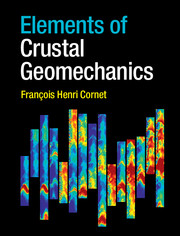Book contents
- Frontmatter
- Epigraph
- Contents
- Preface
- 1 Geomaterials and crustal geomechanics
- 2 Elements of rheology
- 3 Forces and stresses
- 4 Elements of kinematics
- 5 Elements of linear elasticity
- 6 From continuum mechanics to fluid mechanics
- 7 Elements of linear fracture mechanics
- 8 Laboratory investigations on geomaterials under compression 183
- 9 Homogenized geomaterials
- 10 Fractures and faults
- 11 Elements of seismology
- 12 Elements of solid–fluid interactions
- 13 Methods for stress field evaluation from in situ observations
- 14 Elements of stress fields and crustal rheology
- Appendix Elements of tensors in rectangular coordinates
- References
- Index
Preface
Published online by Cambridge University Press: 05 April 2015
- Frontmatter
- Epigraph
- Contents
- Preface
- 1 Geomaterials and crustal geomechanics
- 2 Elements of rheology
- 3 Forces and stresses
- 4 Elements of kinematics
- 5 Elements of linear elasticity
- 6 From continuum mechanics to fluid mechanics
- 7 Elements of linear fracture mechanics
- 8 Laboratory investigations on geomaterials under compression 183
- 9 Homogenized geomaterials
- 10 Fractures and faults
- 11 Elements of seismology
- 12 Elements of solid–fluid interactions
- 13 Methods for stress field evaluation from in situ observations
- 14 Elements of stress fields and crustal rheology
- Appendix Elements of tensors in rectangular coordinates
- References
- Index
Summary
Geomechanics refers to the mechanics of geomaterials, i.e. to the deformation and flow processes that affect the materials which make up the planet earth.
Geomechanics issues are encountered in a great variety of situations with very different scales, both in space and time. Generally, in engineering applications, time scales vary from a few days to a few tens of years and the volumes under consideration vary from a few hundreds of cubic meters to a few cubic kilometers. In earth science, however, time scales range from seconds to tens of millions of years and volumes vary from a few cubic kilometers to that of the entire planet. Accordingly, each domain of application has developed its own appropriation of the geomechanics concept, given that engineers have to deal mostly with perturbations of an existing system, with particular concern for safety issues and production or construction efficiency, while earth scientists are trying to understand natural phenomena such as fault motion, mountain building and sedimentary basin evolution.
For the last 30 years engineers have been confronted with much longer time scales and much greater volumes. For example the development of a repository for nuclear waste must be proved to be safe for up to a million years. The exploitation of geothermal energy or the filling of dams must not reactivate large faults and so trigger destructive earthquakes. Similarly, earth scientists must come up with precise seismic risk analysis, which requires an accurate description of the expected ground motion at specific locations. They must analyze, in real time, deformation fields on volcanoes in order to mitigate the hazards associated with eruption.
Today, geoengineers and geoscientists dealing with the mechanics of earth materials need to speak the same language. The objective of this text book is to introduce the basic principles of mechanics that earth scientists and mining, petroleum, civil and environmental engineers need to apply for solving problems in geomechanics. The only materials which are considered here are crustal geomaterials.
- Type
- Chapter
- Information
- Elements of Crustal Geomechanics , pp. xiv - xviPublisher: Cambridge University PressPrint publication year: 2015



